Page 161 of 474
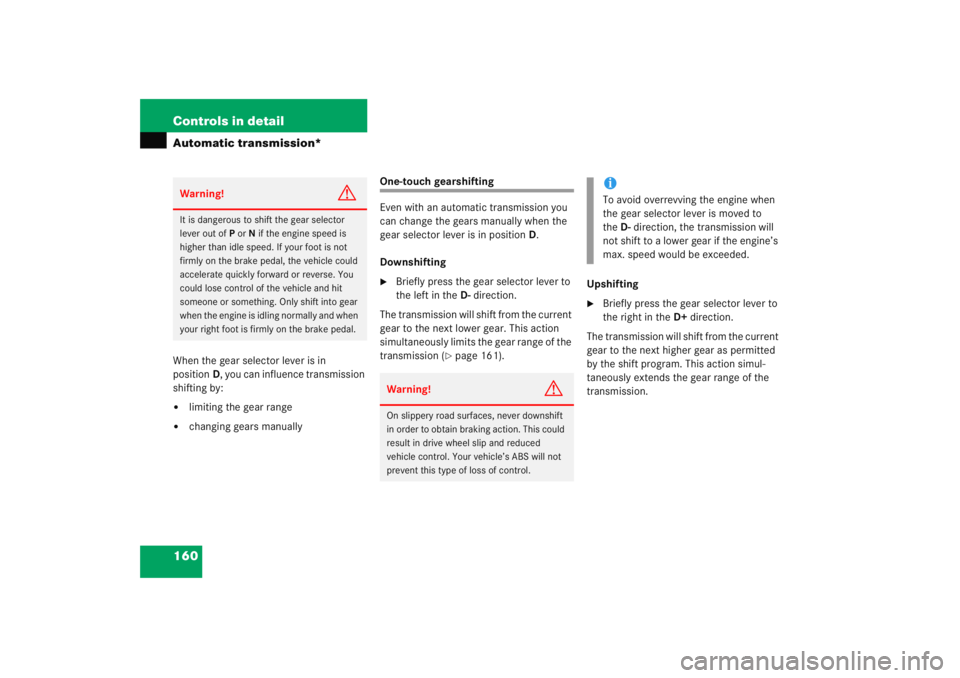
160 Controls in detailAutomatic transmission*When the gear selector lever is in
positionD, you can influence transmission
shifting by:�
limiting the gear range
�
changing gears manually
One-touch gearshifting
Even with an automatic transmission you
can change the gears manually when the
gear selector lever is in position D.
Downshifting�
Briefly press the gear selector lever to
the left in the D-direction.
The transmission will shift from the current
gear to the next lower gear. This action
simultaneously limits the gear range of the
transmission (
�page 161). Upshifting
�
Briefly press the gear selector lever to
the right in the
D+direction.
The transmission will shift from the current
gear to the next higher gear as permitted
by the shift program. This action simul-
taneously extends the gear range of the
transmission.
Warning!
G
It is dangerous to shift the gear selector
lever out of P or N if the engine speed is
higher than idle speed. If your foot is not
firmly on the brake pedal, the vehicle could
accelerate quickly forward or reverse. You
could lose control of the vehicle and hit
someone or something. Only shift into gear
when the engine is idling normally and when
your right foot is firmly on the brake pedal.
Warning!
G
On slippery road surfaces, never downshift
in order to obtain braking action. This could
result in drive wheel slip and reduced
vehicle control. Your vehicle’s ABS will not
prevent this type of loss of control.
iTo avoid overrevving the engine when
the gear selector lever is moved to
the D-direction, the transmission will
not shift to a lower gear if the engine’s
max. speed would be exceeded.
Page 162 of 474
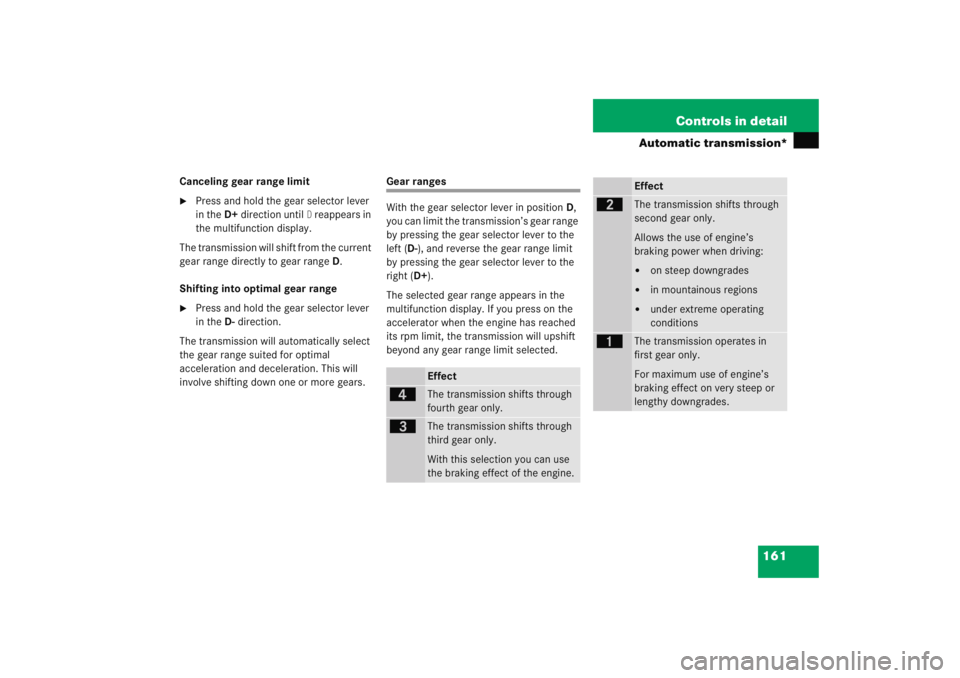
161
Controls in detail
Automatic transmission*
Canceling gear range limit�
Press and hold the gear selector lever
in the
D+direction until
D reappears in
the multifunction display.
The transmission will shift from the current
gear range directly to gear range D.
Shifting into optimal gear range
�
Press and hold the gear selector lever
in the D-direction.
The transmission will automatically select
the gear range suited for optimal
acceleration and deceleration. This will
involve shifting down one or more gears.
Gear ranges
With the gear selector lever in position D,
you can limit the transmission’s gear range
by pressing the gear selector lever to the
left ( D-), and reverse the gear range limit
by pressing the gear selector lever to the
right ( D+).
The selected gear range appears in the
multifunction display. If you press on the
accelerator when the engine has reached
its rpm limit, the transmission will upshift
beyond any gear range limit selected.
Effect
é
The transmission shifts through
fourth gear only.
è
The transmission shifts through
third gear only.
With this selection you can use
the braking effect of the engine.
Effect
ç
The transmission shifts through
second gear only.
Allows the use of engine’s
braking power when driving:�
on steep downgrades
�
in mountainous regions
�
under extreme operating
conditions
æ
The transmission operates in
first gear only.
For maximum use of engine’s
braking effect on very steep or
lengthy downgrades.
Page 163 of 474
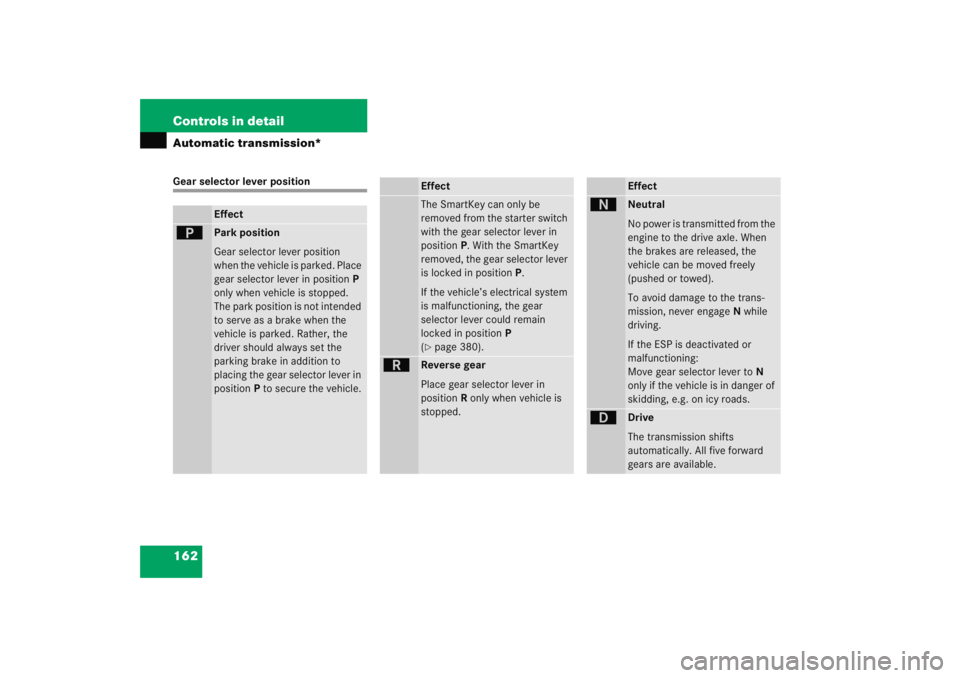
162 Controls in detailAutomatic transmission*Gear selector lever position
Effect
ì
Park position
Gear selector lever position
when the vehicle is parked. Place
gear selector lever in positionP
only when vehicle is stopped.
The park position is not intended
to serve as a brake when the
vehicle is parked. Rather, the
driver should always set the
parking brake in addition to
placing the gear selector lever in
position P to secure the vehicle.
EffectThe SmartKey can only be
removed from the starter switch
with the gear selector lever in
position P. With the SmartKey
removed, the gear selector lever
is locked in position P.
If the vehicle’s electrical system
is malfunctioning, the gear
selector lever could remain
locked in position P
(�page 380).
í
Reverse gear
Place gear selector lever in
position R only when vehicle is
stopped.
Effect
ë
Neutral
No power is transmitted from the
engine to the drive axle. When
the brakes are released, the
vehicle can be moved freely
(pushed or towed).
To avoid damage to the trans-
mission, never engage N while
driving.
If the ESP is deactivated or
malfunctioning:
Move gear selector lever to N
only if the vehicle is in danger of
skidding, e.g. on icy roads.
ê
Drive
The transmission shifts
automatically. All five forward
gears are available.
Page 165 of 474
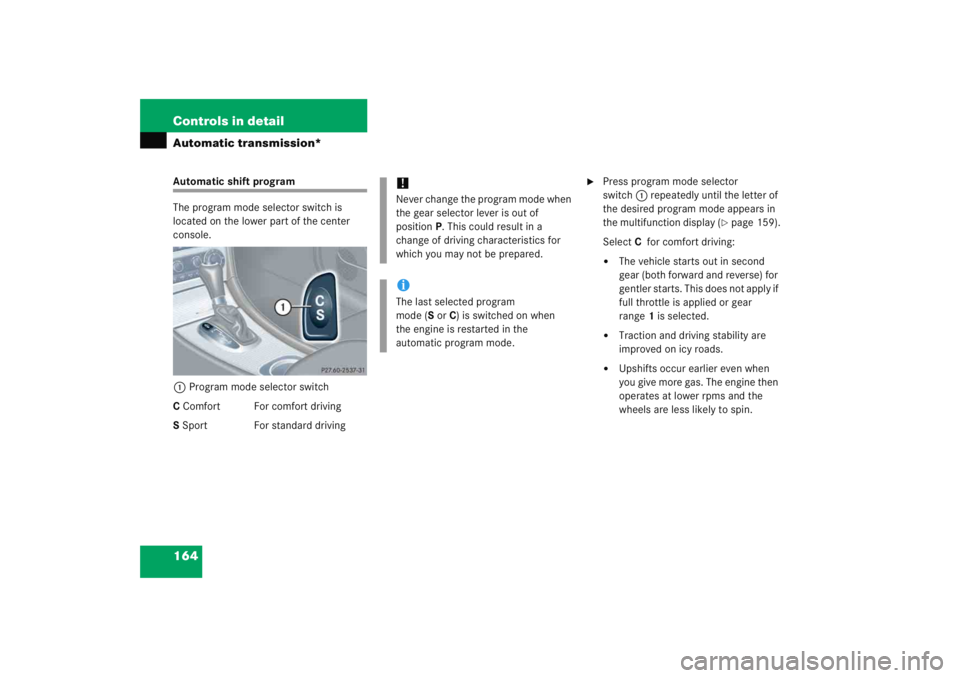
164 Controls in detailAutomatic transmission*Automatic shift program
The program mode selector switch is
located on the lower part of the center
console.1 Program mode selector switch
C Comfort For comfort driving
S Sport For standard driving
�
Press program mode selector
switch 1 repeatedly until the letter of
the desired program mode appears in
the multifunction display (
�page 159).
Select Cfor comfort driving:
�
The vehicle starts out in second
gear (both forward and reverse) for
gentler starts. This does not apply if
full throttle is applied or gear
range 1 is selected.
�
Traction and driving stability are
improved on icy roads.
�
Upshifts occur earlier even when
you give more gas. The engine then
operates at lower rpms and the
wheels are less likely to spin.
!Never change the program mode when
the gear selector lever is out of
position P. This could result in a
change of driving characteristics for
which you may not be prepared.iThe last selected program
mode ( Sor C) is switched on when
the engine is restarted in the
automatic program mode.
Page 166 of 474
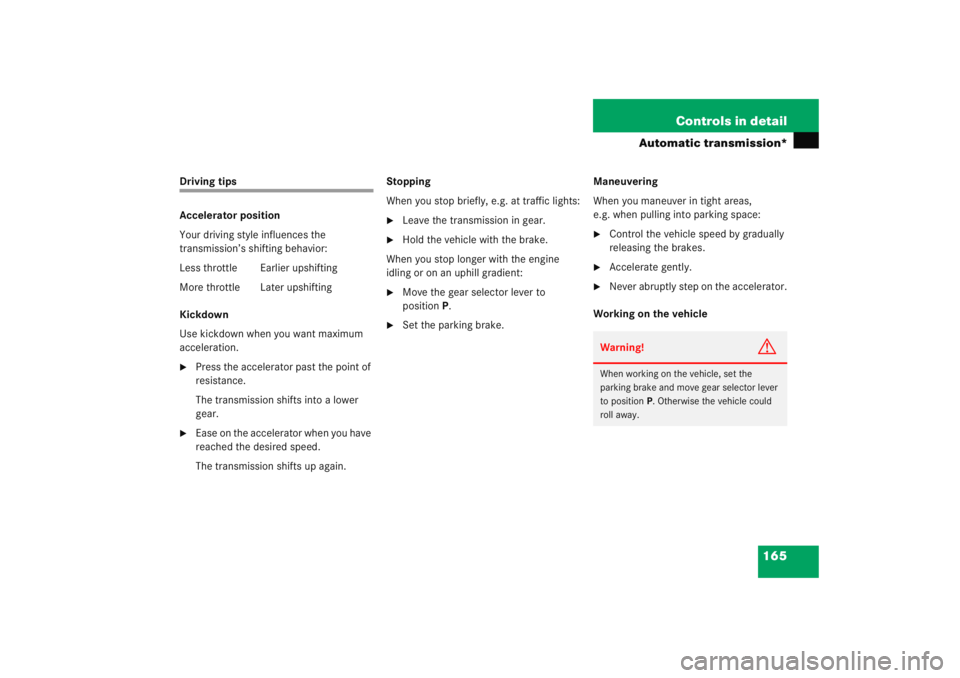
165
Controls in detail
Automatic transmission*
Driving tips
Accelerator position
Your driving style influences the
transmission’s shifting behavior:
Less throttle Earlier upshifting
More throttle Later upshifting
Kickdown
Use kickdown when you want maximum
acceleration.�
Press the accelerator past the point of
resistance.
The transmission shifts into a lower
gear.
�
Ease on the accelerator when you have
reached the desired speed.
The transmission shifts up again.
Stopping
When you stop briefly, e.g. at traffic lights:
�
Leave the transmission in gear.
�
Hold the vehicle with the brake.
When you stop longer with the engine
idling or on an uphill gradient:
�
Move the gear selector lever to
position P.
�
Set the parking brake. Maneuvering
When you maneuver in tight areas,
e.g. when pulling into parking space:
�
Control the vehicle speed by gradually
releasing the brakes.
�
Accelerate gently.
�
Never abruptly step on the accelerator.
Working on the vehicleWarning!
G
When working on the vehicle, set the
parking brake and move gear selector lever
to position P. Otherwise the vehicle could
roll away.
Page 167 of 474
166 Controls in detailAutomatic transmission*Emergency operation (Limp Home Mode)
If vehicle acceleration worsens or the
transmission no longer shifts, the trans-
mission is most likely operating in limp
home (emergency operation) mode. In this
mode only second gear and reverse gear
can be activated.
�
Stop the vehicle.
�
Move gear selector lever toP.
�
Turn off the engine.
�
Wait at least ten seconds before
restarting.
�
Restart the engine.
�
Move gear selector lever to position D
(for second gear) or R.
�
Have the transmission checked at an
authorized Mercedes-Benz Center as
soon as possible.
Page 175 of 474
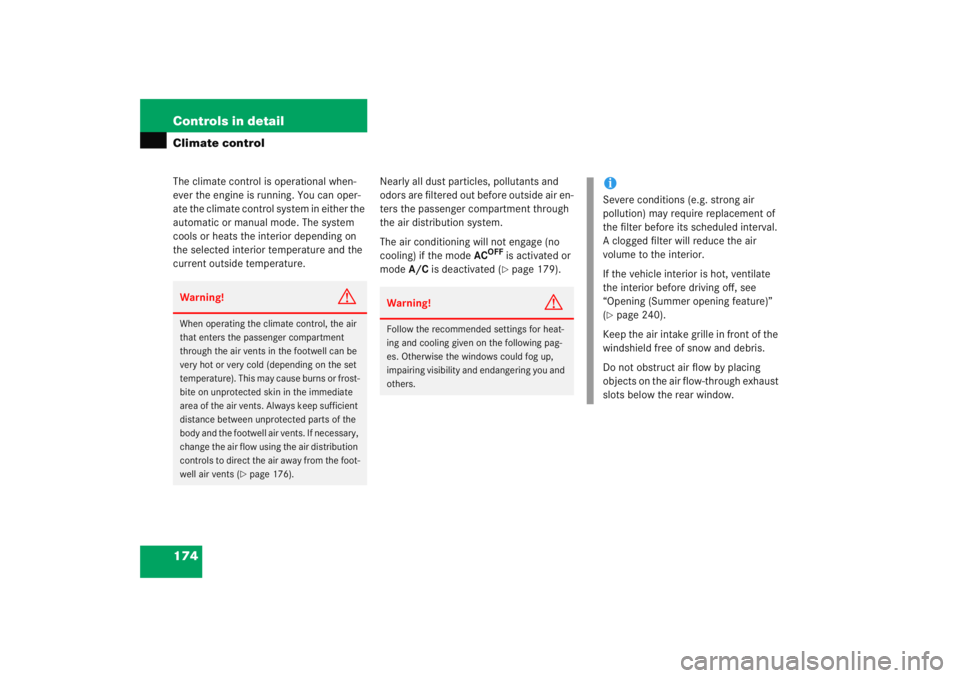
174 Controls in detailClimate controlThe climate control is operational when-
ever the engine is running. You can oper-
ate the climate control system in either the
automatic or manual mode. The system
cools or heats the interior depending on
the selected interior temperature and the
current outside temperature.Nearly all dust particles, pollutants and
odors are filtered out before outside air en-
ters the passenger compartment through
the air distribution system.
The air conditioning will not engage (no
cooling) if the mode
AC
OFF
is activated or
mode A/C is deactivated (�page 179).
Warning!
G
When operating the climate control, the air
that enters the passenger compartment
through the air vents in the footwell can be
very hot or very cold (depending on the set
temperature). This may cause burns or frost-
bite on unprotected skin in the immediate
area of the air vents. Always keep sufficient
distance between unprotected parts of the
body and the footwell air vents. If necessary,
change the air flow using the air distribution
controls to direct the air away from the foot-
well air vents (
�page 176).
Warning!
G
Follow the recommended settings for heat-
ing and cooling given on the following pag-
es. Otherwise the windows could fog up,
impairing visibility and endangering you and
others.
iSevere conditions (e.g. strong air
pollution) may require replacement of
the filter before its scheduled interval.
A clogged filter will reduce the air
volume to the interior.
If the vehicle interior is hot, ventilate
the interior before driving off, see
“Opening (Summer opening feature)”
(�page 240).
Keep the air intake grille in front of the
windshield free of snow and debris.
Do not obstruct air flow by placing
objects on the air flow-through exhaust
slots below the rear window.
Page 180 of 474
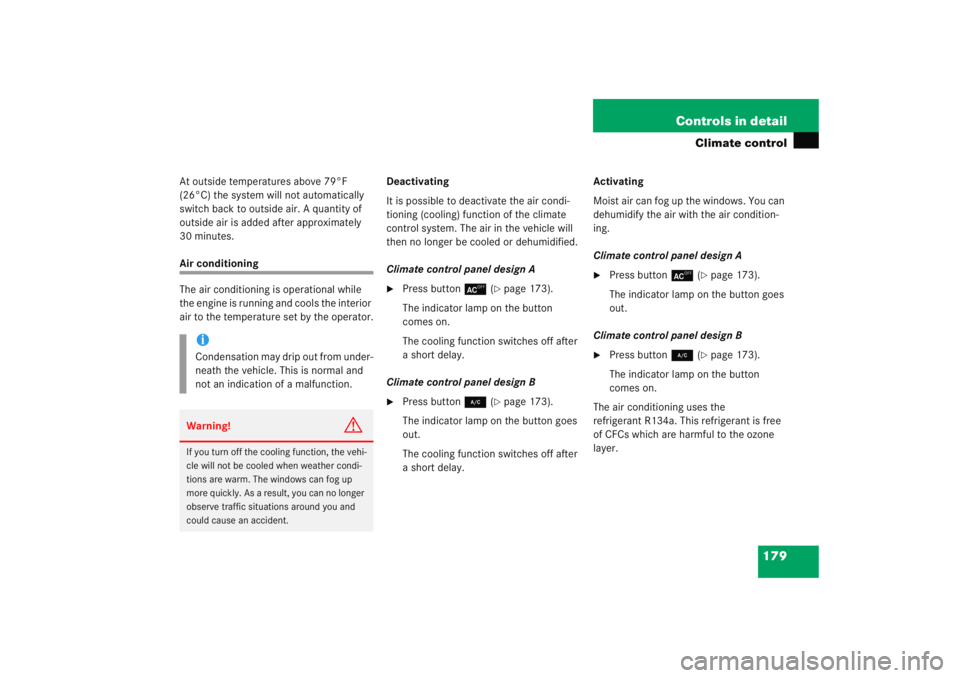
179
Controls in detail
Climate control
At outside temperatures above 79°F
(26°C) the system will not automatically
switch back to outside air. A quantity of
outside air is added after approximately
30 minutes.Air conditioning
The air conditioning is operational while
the engine is running and cools the interior
air to the temperature set by the operator.
Deactivating
It is possible to deactivate the air condi-
tioning (cooling) function of the climate
control system. The air in the vehicle will
then no longer be cooled or dehumidified.
Climate control panel design A
�
Press button
± (
�page 173).
The indicator lamp on the button
comes on.
The cooling function switches off after
a short delay.
Climate control panel design B
�
Press button 2 (
�page 173).
The indicator lamp on the button goes
out.
The cooling function switches off after
a short delay. Activating
Moist air can fog up the windows. You can
dehumidify the air with the air condition-
ing.
Climate control panel design A
�
Press button
± (
�page 173).
The indicator lamp on the button goes
out.
Climate control panel design B
�
Press button 2 (
�page 173).
The indicator lamp on the button
comes on.
The air conditioning uses the
refrigerant R134a. This refrigerant is free
of CFCs which are harmful to the ozone
layer.
iCondensation may drip out from under-
neath the vehicle. This is normal and
not an indication of a malfunction.Warning!
G
If you turn off the cooling function, the vehi-
cle will not be cooled when weather condi-
tions are warm. The windows can fog up
more quickly. As a result, you can no longer
observe traffic situations around you and
could cause an accident.